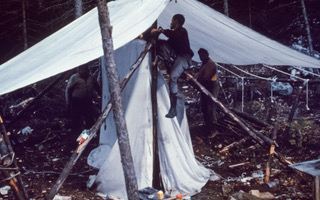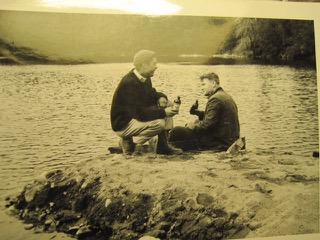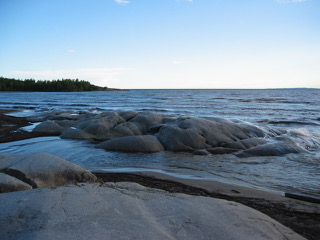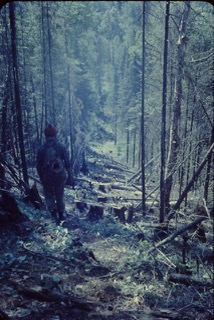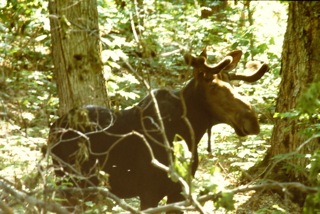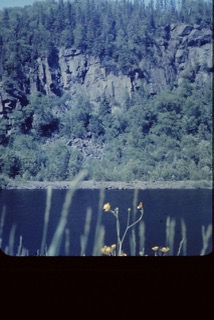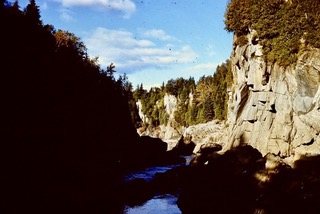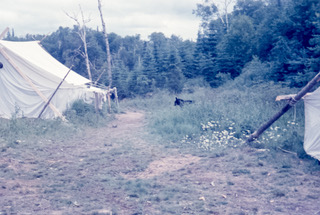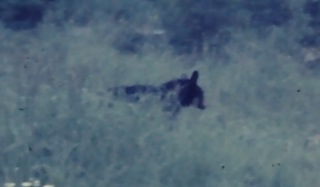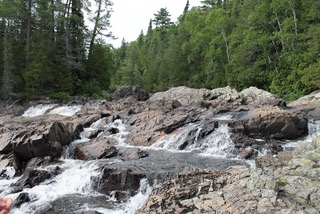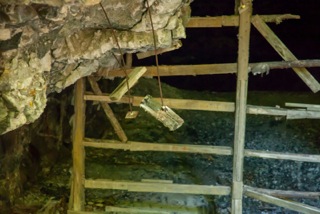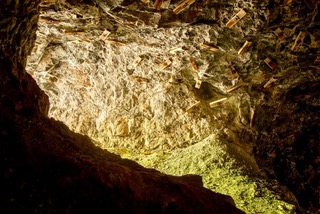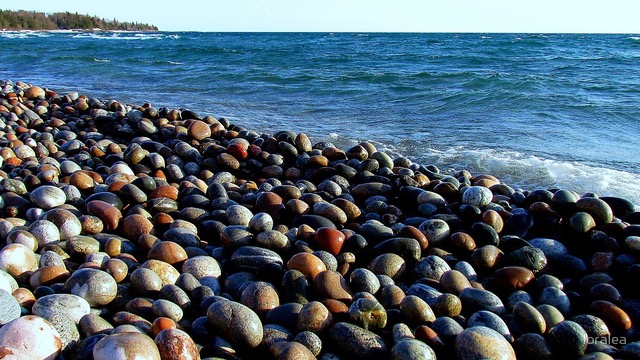



 upload.wikimedia.org/wikipedia/commons/thumb/9/92/Slate_Islands_Shattercone.JPG/300px-Slate_Islands_Shattercone.JPG 2x” data-file-width=”1728″ data-file-height=”2304″>
upload.wikimedia.org/wikipedia/commons/thumb/9/92/Slate_Islands_Shattercone.JPG/300px-Slate_Islands_Shattercone.JPG 2x” data-file-width=”1728″ data-file-height=”2304″>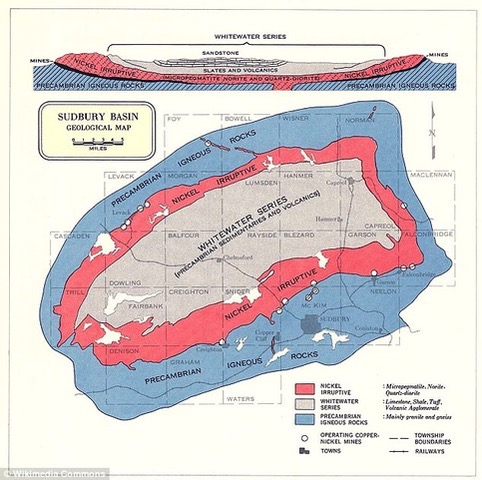

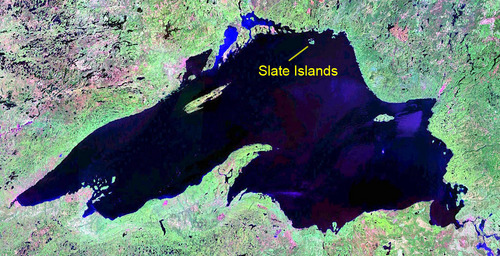
SUMMER 1963, 25 YEARS OLD…TO BE MARRIED AUGUST 24…IN THE BUSH UNTIL THEN“Mom, this could be my last summer in the wilderness… I want to make the most of it.”“Where will they send you this year, Alan?”“Never know until the day before departure…remember the Irish job?…Dr. Paterson had said I was being sent to the Mexican / USA border/““Yes, and I worried about snakes.”
“And I read a first aid noe on snake bites…if bitten cut the place a bit and suck out the blood and venom. I told Mom there was no real danger and there wasn’t .
“Then the next day everything changed and I was on a plane to Southern Ireland.”
“This will be our last year in the bush. How does Marjorie feel about it..You’ve left her with allthe marriage preparations.”“She’s not wildly enthusiastic. But accepts things as they are and we’ll need the money for the honeymoon.”“Is that the story you told her?”“Yep.”“I doubt she believes you. I think she just knows you have to get the wilderness out of your system this one last time.”(As things turned out there were still two more summers ‘in the bush’…but Marjorie joined me on those venture. On one job
she even brought or cat Presque Neige and her sewing machine. Gave the boys quite a laugh since hungry wolves howled every
Dr. NORMAN PATERSON SETS UP THE JOB
“Back for another summer, Alan?”“Where to this time?”“Marathon”“Marathon?”“North shore of Lake Superior…lots of wilderness for you.”“Black flies, deer flies, horse flies, blow flies…and Mosquitoes…the usual greeters.”“Putting you in charge of the operation this year, Alan.”“Meaning?”“Set up the camp, conduct the surveys,..”“Dig the latrine, get the grub, cook the grub, put up the tents, protect the instruments.”“All that…”“Who does the interpretation?”“John Lloyd, a Welsh geophysicist…”“He’s the brains, right?”“But never been in the bush.”“Just two of us?”“No. David Murphy, an Irishman, and Bill Gilbey, a Brit, and Roger Nicholls, a student…five of you ““And the linecutters?”“Already up there setting up the grid…French and aboriginal bunch. They know their job.”AND SO YEAR EIGHT, 1963, BEGAN
Journal Entries
TO say Marathon was a smelly place is to flatter
Tuesday May 21, 1963: “Well, here I go…another summer. Drove our 1953 Meteor to office in east Toronto which meant Dad had to take a whole series of busses and streetcar to get fromwest Toronto to his job a a tire builder in Whitby. He did not complain. Met our crew Bill Gilbey, David Murphy and John Lloyd…a Brit, Irishman and Welshman…hoped these guys could get along.Roger Nicholls still in high school. Bought train tickets and cashed $4o0 expense check. Phoned Marjorie in North Bay to say good-bye for a while. She is not too enthusiastic as we havebarely got engaged and I am taking off leaving her to make the marriage arrangements. Marjorie does not really complain since we will need the money to finance out honeymoon after theAugust 24 wedding. Mom and dad drove me to Union station with my single rucksack filled with stuff to last two months. Socks are the most important items…big thick socks. Gum rubbers boilsmy feet as water always gets in so dry socks each day are crucial. After 7 years in the bush my feet are pock marked like a World War II battlefield. Our crew have a compartment on the train…a luxury.We spent two hours in the dining car scarfing down a great roast beef dinner ($3.86) then climbed up into the Scenes Dome and watched the settled landscape slide into an endless boreal forest.We got off the train in MacTier to stretch our legs. Cool up here…even cold. Some girls in the next compartment offered to share a mickey with our crew as they think we are big shot mining guys.Really we have no idea what we will doing. Lulled to sleep by the staccato music of the rails.”Wednesday May 22, 1963: “Winter vista all around when we awoke and faced a blizzard from Sudbury westward. Waiter lamented “Don’t want no more snow” at breakfast then we climbed intothe Dome to enjoy the snowstorm. Crossed my fingers that storm and snow would be gone by the time we got our tents erected. Bunch of British immigrants in the dome with us so Bill Gilbeyhad great time socialising. Bill is really an extroverted kind of guy. Same age as me. I think we are going to have a grand summer. Bit premature comment …said before we arrived in Marathon.The town has a vile smell that cannot be escaped something to do with the manufacture of cardboard from pulpwood logs H2S, Hydrogen Sulphide gas known unpopularily as ‘rotten eggs”.The smell covers not only the town but also much of the nearby forest where we will be doing our survey. I wonder if H2S become H2SO4 once it hits our moist lungs. Sulphuric Acid. Well , we will just haveto put up with it. No escape. I fear the acid air with affect Roger Nicholls who already has a throat and lung problem called ‘Quinsy’. Must carry on. Rented a truck for the summer fromK.T. McKaig and then bought a load of lumber from Marathon Corporation for our base camp. Drove to Heron Bay, southeast of Marathon, a native community close to our survey site. Locatedour base camp near there on Highway 17. Wilderness all around. Made sure the Department of Lands and Forests knew what we were doing. Unfortunately our gear has not arrivedso we checked in to the Everest Hotel for the night. Expense money nearly all gone now. Finally we met Mr. LaMotte who is in charge of our linocutting crew. Some lines already blazed so we start right awayif our gear ever gets here.”Building a campsite is a messy business. Geophysical prospecting involves lots of movement. Setting up a sleeping tent under a coveringfly tent is not as easy as it sounds. This picture was taken at an earlier location but gives the general idea os what is required.
Thursday May 23, 1963: “Camping gear still has not arrived so bought new coking gear and pile of canned food, Kraft dinners, peanut butter. The usual stuff. This town really stinks with that rotten eggsmell. People seem to accept the smell so we must do the same. The flies do not seem to mind the smell at all … seems to make the bloodsucking bastards even worse so used my credit account withthe company store to stock up on fly sprays. Chose a campsite a few miles outside town beside a little lake where gravel had been scooped out for the Trans Canada Highway. cleared brush and erected first tent, then dug a latrine downwind from the tent a short distance away since using a latrine… always a challenge for the bugs loved a stationary body…easier to draw blood. In addition Latrines offer more exposed flesh as well. Need a windy spot with some shelter. Not such a easy task. Then we dug a meat hole in which we planted a new galvanised garbage can…a substitute for a refrigerator. We will have to use our noses to check the meat occasionally. Hard to do because of the goddamn H2S in the air. Cooked supper — minute steak, rice, mushroom, carrots, peaches and cookies topped off with best coffee I have every boiled (which is not really saying much) . Washed dishes and then crawled into sleeping bags by candlelight. No cots yet so slept on the ground. Bill and David hookef up our radio antennae. Log jam in the river below. Looks like cold cold nights. Snow still on the ground in patches.”FridayMay 24, 1963: Drove west to Pic River to make Latitudinal correction on instrument…could not zero it much less than 200 gammas. Then explored and mapped logging roads through our designated survey area. Visited line cutter, Mr. Leblanc, who has cut as far as 104+00 South. Planned to start survey but truck got bogged down in loose sand…deep as hubs, no way out. Walked all the way to Marathon to get a two truck…hours. Still no sign of cots and cooking gear. bought food. Heard the Anaconda crew were coming this week end. Our clients. They have a crew of twelve men and plan to use same site as ours…this is not a good idea as we willed time to interpret our results. I would prefer that we do this without the Anaconda men looking over our shoulders. Nothing against them but interpreting survey results is a very tricky thing best done in isolation. So we changed our site quickly…surreptitiously Found a small gravel pit lake about 10 miles from present location and made our move tonight…long tough job involving two trips with truck…Tent(s) taken down and one pitched in the dark. Supper at gas station run by Finnish couple. Hooked up stove and then sacked out.This is the 24th of May … big time holiday in Canada but no holiday for us. The little devilish black flies air not on holiday it seems from the blood specks on my body.”
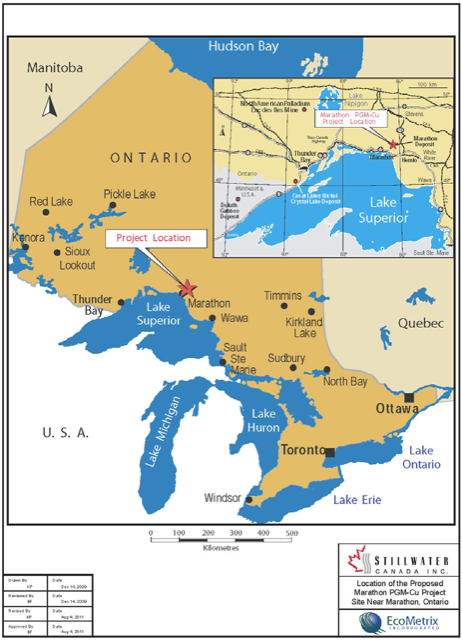
Even though the campsite was cold an miserable in tho first few weeks, Bill Gilbey andDavid Murphy enjoyed cool bottles of Red Cap Ale. Alcohol was not common in ourcamp. This was a celebration after the tents had been erected. No cots arrived sowe were sleeping on the ground and needed something to sooth our acing backs…hencethe Red Cap ale.
WHAT IS KNOWN ABOUT THE ANOMALY? ANY EVIDENCE OF COPPER?


Saturday May 25, 1963: Up early…hard to sleep on ground, wish cots would arrive. Straightend up camp…our little lake looks nice, really small but deep and clear. Got some lumber to build tables, racks, maybe a bit of a dock to make it easier to dip water…Drove to job site…did lines 104 South to o-4000 East then 112 South to 0-4000 East. Checked with linecutters. Strange thing about working in the bush is that we rarely see other human beings…line cutters are ghosts. Hot and dry day. Forests getting tinder dry…must be very careful. Lucky no one smokes. Back in camp sent letter to Barrie Nichols at Hunting Tech and Exploration Services. No gear yet. So will buy what we need in Marathon. Phoned Barrie—all clear to buy what we need. Put up our cook tent and began construction of kitchen cupboards (really just shelves). Lousy meal cooked by Bill Gilbey…guess he has a cook and maids back in England. Bill now realising that dirt is part of bush life…”Blimey, I’m going to have a wash!” Lake water cold as ice. but Bill dove in. Warm in our tent though. Candlelight but no wine. Tomorrow the bush again…routine begins. Squirrels are mating as are the partridge. Phoned Marjorie from town…nice to hear her voice…always upbeat.Sunday May 26, 1963: “Breakfast smells good.. French toast, bacon, juice, coffee, porridge, milk. David Murphy and I headed into the bush for the day doing lines 144 and 152, East and West, then 160 West. No water at all…frozen. Ate snow for lunch…lots of that still around. Evening supper a failure. Weiners were mouldy but we ate them all the same. Plotted our results on graph paper. “It’s getting chilly around my legs and back…how about some linoleum for the floor…or even a carpet.” comment by Bill Gilbey who was beginning to understand the limitations of bush life.Monday May 27, 1963: Bill Gilbey keeps us laughing. “We’re in pretty bad shape when we have to find our pornography in Eaton’s catalogue.” He was flipping the pages, “Stockings, eh, must be shoes next…heading for the lingerie!” The night was dreadful. Wind destroyed the cook tent…kept Bill and I up all night. The stove overturned but no fire started. Late start. Did lines160 and 168 East, 168 and 192 West. Bill Gilbey is going to work out fine. David Murphy cooked breakfast. Really hard walking the bush spongy swamp and then dense stands of tag alder. Movement difficult until we reached a rock shelf 1500 feet above the shore of Lake Superior. Stunning view of the vastness of Lake Superior. Human presence was totally absent…as if time rolled back a thousand years. Somewhere out there are the Slate islands where a meteor hit the earth in ancient times. A whole bunch of meteorshit back then with devastating results. Drove to Marathon in evening and bought box of beer. Nice to get Mail from Marjorie. Gear finally arrived. Built table for cook tent. Evening storm expected…tent billowing dangerously. Bill Gilbey getting serious about Eaton’s catalogue. Tore out pin up girls in female underwear.Inside our cook tent at the Marathon Camp. I got very handy at building kitchen cupboards on our campsites. Unfortuanntley thiscupboard contaiined a lot of food that a roving bear would find tasty. If you were a bear what would you want from our larder.A real bear eventually showed up and helped himself.The flies do not seem to mind the smell of the place. Flesh sucking bastards even seem hungrier. So stoked up with fly sprays and creams. Chose a campsite a few miles outside town beside a little lake where gravel had been scooped out for the Trans Canada Highway. cleared brush and erected first tent, then dug a latrine downwind from the tent a short distance away since using a latrine… always a challenge for the bugs loved a stationary body…easier to draw blood. In addition Latrines offer more exposed flesh as well. Need a windy spot with some shelter. Not such a easy task. Then we dug a meat hole in which we planted a new galvanised garbage can…a substitute for a refrigerator. We will have to use our noses to check the meat occasionally. Hard to do because of the goddamn H2S in the air. Cooked supper — minute steak, rice, mushroom, carrots, peaches and cookies topped off with best coffee I have every boiled (which is not really saying much) . Washed dishes and then crawled into sleeping bags by candlelight. No cots yet so slept on the ground. Bill and David hookef up our radio antennae. Log jam in the river below. Looks like cold cold nights. Snow still on the ground in patches.LAKE SUPERIOR
“Third largest freshwater lake in the world by volume…the largest freshwater lake in the world by surface area. The Ojibwe people were aware of this, naming it’ Ojibwe Gichigami’ …Ojibwe’ Great Sea. Great indeed. The Lake covers 31,700 square miles ( 82,103 square kilometres). Average depth is 483 feet…enough water to cover North and South America to depth of one foot. Big…gigantic.Geologically the north shore of Lake Superior dates back to the origin of our planet. The North Shore exposes the ancient granite rock. called the Canadian Shield. 540 million years ago the churning magma from the earth’s interior forced its way to the surface bringing with it valuable minerals such as Copper, Iron, silver, gold and Nickel. Hence the interest in mining exploration in tis part of Northern Ontario. The mountains born of this volcanic past have been eroded down to the smooth hard surface common to Lake Superior shoreline. Ten thousand years ago during the Wisconsin glaciation ice covered the area to a depth of 1.25 miles (2 km). I always find that fact hard to believe…ice over 2 km thick towering above wherever I stand in Ontario. Mountains ground down and made as smooth as a baby’s bum. And then, incredibly, the surface of the earth was split creating some of the deepest rifts in the world. It is these rifts that have filled with the melted glacier water. More lava pushed its way up to the surface melting its way through the sedimentary layers left by the ground up mountains….called diabase sills. Cavities filled with amethyst in some place…semi-precious stone. When the ice melted in a period of global warming ten thousand years ago, the rift valley filled with water and the land rose once the weight of ice was removed. A Gap in the rock at Sault Ste. Marie stabilized the lake surface. This rock was Important to my employers in the summer of 1963 because along with the magma came lots of minerals located in pockets all along the north shore of Lake Superior. The job was to find those pockets and then get a diamond drill in to confirm the presence of copper.When the ice melted, the Plano people moved north with their stone tipped spears to hunt and kill caribou along the shores of the great lake, then even greater than it is today.. They are A mysterious people of whom little is known. Then came the Shield Archaic people (5,000 to 500 BC) who used bows and arrows, made dugout canoes, traded with other peoples to the south. Significantly they were miners…first miners of the region…converting raw copper into tools and weapons. Direct descendent of the current Ojibwe and Cree. From 500 BC to 500 AD the Laurel people were making fish nets on the Pic River where we were about to do our search for mineral wealth.Other aboriginal people arrived with snow does, birch bark canoes and domed lodges.The people First Nations people lived nearby Herons Bay and call themselves the Anishinaabe, also called Ojibwe or Chippewa. They became the dominant people of ‘Great Sea’ forcing others to flee south and west and east“YOU ARE COMMON, ALAN, VERY COMMON.”
That comment was the closest I ever got to British upper class ‘holier than thou’ put downs.Common? What did that mean? Seems to infer some kind of inferior status. Common as opposed to ‘special’. The division of people into upper class and lower class. Obviously I was put in the later category.This happened long ago when I was sitting around a campfire with a bunch of older Boy Scouts, most of whom I knew well. One scout was new. a visitor to Canada. He was very British as he spoke with a kind of nasal huff and puff voice. I did not make fun of him. I hardly knew him but for some reason he took a deep dislike of me. Then, out of the blue, he called me a ‘commoner’ thereby placing him in some kind of elevated class. What should i do? Fist fight? No. I am not a fighter for I learned long ago that people get hurt fighting. As a little boy I watched gang fights in Dufferin Park where lead pipes and broken bottles were weapons of choice. Then I fell on one of those beer bottle shard weapons and still have the leg scars to remind me that violence should be avoided wherever possible. What should I do? Fire back some kind of return comment like ‘Fuck you…you mealy mouthed so of a bitch!” I had picked up these words mostly from my Dad’s advanced lectures in the fine use of language.. What to do? I did nothing. Just looked at him with steely eyes. But I never forgot.Then here I was, years later, working with Bill Gilbey, another Brit. Did he have the same attitude towards colonials…the same view that those born without a silver spoon in their mouths were Commoners. My grandfather had left England in 1908 to get away from the class system. “Got sick and tired of tipping my cap to the gentry at Eywood.” (* footnote 1) Seemed that the The Gilbeys were member of the British upper class according to scuttlebutt at company HQ. But All I really knew about Bill was that his family name was plastered on Gin bottles in Canadian liquor stores. Who were the Gilbeys? Should I expect to be called a Commoner in our bush camp outside Marathon? Could Bill take orders or just give them? Were we heading for trouble?Nothing like that happened. Bill was a most enjoyable guy to work with…he revelled in hard work, cursed the blood sucking flies like the rest of us and, most important, had a wonderful sense of humour. Best remembered was his comment while leafing through Eaton’s catalogue. “So it has come to this, boys, we are turning to Eaton’s catalogue for our pornography” as he gazed at the advertisements for brassieres and girdles.The Gilbeys are baronets? Members of the aristocracy. Well, not quite. A baronet is not a member of the ‘peerage’ who are the real blue bloods of the class system. Baronets come from the great unwashed masses called Commoners. Elevated if you please. Walter Gilbey, in 1893, was designated a baronet for one of three reasons. First, his success in the manufacture and distribution of gin, wine and other hard liquor. Two, he was a great admirer of horses and wrote many books on the subject of shire horses. Three, he made jam. Jam? he demonstrated thatEnglish estates could grow fruit crops that could be boiled down into damn good jam. Part of his 900 acre estate was devoted to the jam business. So he became a baronet either by being recognised as a great businessman or by buying is way into the class…maybe a bit of both.Before that election the Gilbeys had a stagecoach business. That ended with the railway boom.“Maybe we could make money selling cheap wine from South Africa…try to ween locals away from beer.” They never looked back. In no time the Gilbeys had 20,000 customers. Gin making followed. Success breeds success. Every time I see friends ordering a glass of red wine instead of a pint of beer, I think of Walter Gilbey. Most of my friends are Commoners. Most still drink beer.The British class system. The Royals and Peers all belong to the authentic upper class. They have names for themselves in a fixed order. A Duke is the highest…thenEarl, Marquess, Viscount, Baron. In 1996 there were 1198 peers qualified to sit in Briths House of Lords. No, I do not know if there enough seats for them all. Some peers had multiple titles.Up until 1963, the year Bill joined me in Canada, there were a few women peers but none were allowed to sit in the House of Lords.As mentioned the Gilbeys are Baronets which mean they are not peers…not qualified to sit in the House of Lords. So just what is a baronet? A person who has bought or been given a ‘courtesy title’ that allows them be called ‘Sir’ or “Lady” but never “My Lord”.Bill Gilbey never once made mention of this so none of us called him Sir. I think he would have been offended if we dared do so. Bill was a commoner just like the rest of us…no better, no worse. Industrial and marketing skills in the business of making Gin. Gilbeys Gin can still be found in liquor stores although no Gilbey now involved. Bill’;s grandfather became a baronet in 1897. Before that they ran horse driven taxis, a business rendered unprofitable once the iron horses…the railways…criss crossed England.BLIPS AND STRAIGHT LINES:Our job was not very sophisticated. We tried to find blips…spikes…anomalies. We walked up and down straight lines that were cut by linecutters at right angles to a base line that could be a couple of miles long. As I walked on the line, I stopped at every hundred feet and took a readingwith various geophysical instruments. Some readings were visual…sone readings were auditory depending the machine. All readings had numbers which I wrote down in my Field Notebook.When I rented to camp these readings were plotted on graph paper…sometimes I did this but most of the time a better qualified geophysicist did the plotting. We were looking for blips…for anomalies that diverted from normal background numbers. These blips cold indicate the presence of conducting mineralization deep below the ground. No one really knew what the bliprepresented until a diamond drill crew was assigned to the blip. Diamond drills extricated long drill core…a long piece of cylindrical rock that penetrated the blip. With luck…whit rare luck…there would be lots of chaco pyrite in the drill core…lots of copper,ore which is a fine conductor of electric or has high magnetic qualities. Audio Frequency Magnetometers and Electrical resistivity instruments gave the readings.The earth is a strange and wonderful piece of rock on the surface but underneath is a molten core that sloshed around and sometimes spews out molten rock from cracks in the earths surface. This sloshing beneath the earths crust creates the earth’s magnetic field. Invisible but necessary for all life and living things on the earth. Without the magnetic field our atmosphere would be stripped away as has happened on Mars. The sun is both a source of light and life but also a source of solar wind. Solar wind, if unchecked, would destroy our atmosphere. That does not happen because out magnetic field extends far into space and deflects most of the solar wind like a car windshield deflects air and rain and snow on the highway.What creates this magnetic field? Sloshing around of the molten core of the earth I think. The Heavy iron core of the earth is sold. The next inner layer is molten lava. The sloshing of this material aided by the earth’ rotation creates dynamo effect…an electric magnetic field.North pole and south pole … one positive, one negative. magnetic pole are somewhat different from the geographic poles. Magnetic pole move around but that takes thousands of years to do so. Apparently the poles have even reversed over time which allowspaleomagnetic archeologists to date rock strata. Confusing? You bet. Much remains mysterious. Is the magnetosphere around the earth weakening. Is the movement of the poles accelerating? The North Pole moved 40 kilometres eastward in 2003. What does this mean?Will more cosmic radiation from outer space reach earth and cause havoc for us? Will more particles in the solar wind also reach earth. Both of these could strip our atmosphere. That does not sound good, does it? But who really knows.? Not me.Where did I come in? How come I found blips? What could these blips mean? Well, geophysicists believe some of these blips…they called them anomalies…could indicate pockets of valuable mineralization in the earths crust … could be confirmed by diamond drill cores.And ‘bingo’, a mine!Mystery remains. An Invisible Electromagnetic force blankets the earth and extends far into space The core of our earth is a dynamo of heavy metal at the centre and molten magma covered by a thin crust on top Our oxygen is provided by the plants that coexist with us as long as we can get sunlight. Sunlight can be lethal if al the solar radiation hits the earth. Lucky for us the earths magnetic field deflects much of the solar radiation. And our magnetic field also deflects the potentiallly lethal cosmic rays that come form deep space. Geophysicists understand these relationships.The earth is not one homogenous entity. Lots of materials can be found in the earths crust…like copper, gold, silver…and iron. The crust of the earth is a giant stew. Our job was to find the best parts of the stew using distortions in the earth magnetic field. What do you like in stew? Carrots? Beef? Onions? Well my job was to find copper deposits (chalcopyrite).METEOR IMPACT“Not too far out there in the lake are a bunch of small islands.“So what?”“Unusual islands. About 450 million years ago a bunch of large meteors peppered north America. The meteor that hit Lake Superior created a crater that was 20 miles in diameter (32 km).”“Meteors create holes in the earth, not islands…are you sure a big meteor hit out there?”“yes, The impact crater has been eroded away for the most part.”“Shouldn’t there be a big hole?”“Meteor impact blasts rock with terrific force. Takes weight off and that triggers uplift in the centre.”“You said something about a bunch of meteors, not just one meteor.”“Yes, a bunch of them hit the earth…Slate islands, Iowa, Oklahoma and Wisconsin…impact craters remain.”“How come we can see the craters on the moon but cannot see many on the earth.”“erosion, volcanoes, forests, oceans, plate tectonics…our earth hides things.”“How do you know the meteor hit 450 million years ago?”“I don’t know for sure…some geologists think the impact was even older…say 800 million years ago.”“Any evidence?”“Shatter cones…”“Shatter cones?”“Rare things created by high velocity shock waves when meteors hit the earth. The Slate islands display one of the largest shatter cones in the world.Proof a big meteor hit here.”“Just for curiosities sake, how old are the regular rock under Lake Superior?”“About 2.7 billion years old…some of the most ancient rock on earth.”“How old is the earth anyway?”“About 4.5 billion years old.”“Is the Slate Island meteor strike important?”“It is one of the top 25 impact craters in the world.”“Can Igoand see it?”“Not likely…few people ever visit the Slate islands…that’s why the government airlifted a bunch of Woodland Caribou to live there…few people and no wolves.”METEOR ARMAGEDDON:
Does a doomsday in the past mean we will face a doomsday in the present.‘It ain’t necessarily so’. as the song says. About 90% of the asteroids that could threatenthe earth in the next hundred years have been identified. Could an asteroid heading our way be deflected or exploded? There was a Hollywood film that a team of suicidal astronaughts
landing on an asteroid for an earth impact. In the movie the astronauts planned to drill into the asteroid and bury a nuclear bomb. Well, that is fantasy. Could be done but NASA and other space
scientists suggest an easier way. Simply have an unmanned rocket push the asteroid a few centimetres off course. It will take a century or more to read earth and by thattime will be on a near miss or complete miss trajectory. Yes, Virginia, we can protect ourselvesTuesday May 28, 1963Bedrock at Neys Provincial Park…a few miles offshore are the Slate Islands where a large meteor struck the earth some 480 million years ago.The bedrock in the foreground of the photographed is about 2.7 billion years old…yes ‘billion’ years old.TASK: Use your imagination. A huge meteor is about to strike Lake Superior straight ahead o you. The sky is alight then comes impact. Now imaginethat sky after impact….!!! Why is the earth not pock marked with impact craters like the moon? Answer: covered by lava, greenery, water, movement of tectonic plates…perhaps.How many of the five mass extinctions on earth were caused by meteors? How many were caused by rips in the earth’s mantle and outpouring of huge…immense…flowsof lava? How many cannot be explained? Are we in the midst of the sixth extinction as scientists say? Geophysical prospecting makes a person think.Tuesday, May 28, 1963: Cold and overcast. Set out early for the bush and did lines 192 and 184 East, 184 and 176 West. Had David Murphy operating the instrument in afternoon. Emerged on shore of Lake Superior. Stunning. Like that Group of Seven painting of bare rounded rocks and infinity of steel grey water. Gathered driftwood for big fire and made billy can of hot tea. Billy can is a fruit juice tin with a wire top handle. Must have got that name from drifters in the Great Depression. Who was ‘Billy”? No idea. Tea is easy to make. If we have no tea we can use the Labrador Tea leaves…a plant with conical leaves that are fuzzy underneath. David and I discussed the Irish problem…what a mess. We agreed. Bill Gilbey prepared a fine supper for us after we got the stove back in working order. Shaved and then we drove into town to see Steinbeck’s “Wayward Bus” in film form. Had ice cream at Marathon’s only restaurant. The stink of the cardboard making plant took some joy away from the ice cream. Tomorrow I’ll do the plotting (looking for blips). Pope John is in bad shape. Bill Gilbey announced that “I can’t stand history…dreadful things have happened, best not to read about them.” Odd comment. We are getting used to his odd comments. Hilarious to see him flipping through the women’s underwear section of Eaton’s catalogue. “Look at this boys…a winner for sure but no phone number.”
Wed. May 29, 1963: Delightful rain in morning. We could all sleep in. Cooked grub late in morning. Drove to Marathon. Expense check arrived and a letter form Bill Dunn. We had worked together in the Yukon where he nearly got knifed by a native girl hw was screwing. Bill was quite a character. Some age as me. Ended up in the Yukon when his friends got him drunk and put him on a plane to Whitehorse the day before his wedding. He never Looked back. I am not sure if I told Marjorie that story. She might think the same tragedy could happened. Not a chance that. Bill Dunn was enjoyable and loyal in spite of that ‘left her at the alter’ event. Maybe the girl was lucky for he was not the marrying kind.My brother Eric graduated from U. of T. Looks like we will both be history teachers. Who could have predicted that three years ago? In afternoon I plottred our survey results while Daving and Bill did line 176 East. Rain lasted until 2 p.m. Steak for supper then visited our client Al Boerner (Anaconda Corporation) in the evening. He was nice. We went to the Northern Bar and had pleasant discussion over three beers. Drunken native Canadians also present. Sad. One passed out with his eyes and his fly wide open. Not really funny. The natives are really nice people when sober and super friendly when drunk. I like them. Drive back to camp where boys were waiting up. I still have not had time to put my bed together so another night on the ground. Gilbey spoke again: “gosh they make camping look nice…if they only knew what really happens. Like our tent falling down three times in one night. Sleeping on ground with rock for a pillow. Camping can be torture.”Our line cutters sometimes did a terrific job as in the picture above. They clear cut straight lines for us and then set out picketsevery hundred feet. We walked these lines and took reading at each picket. Sounds simple. But most lines were not like tissometimes they were just marked by blazes on the trees and then tag alder pickets rammed into the ground at the reqired inervals.And sometimes the lines ended abruptly in a steep cliff or a small lake.Thursday May 30, 1963: I did not want to get out of bed this morning but did so once breakfast was ready. Bill Gilbey and I went to the property and did lines 144 East and West, then 136 East, 136 West, 128 West. Very rough going…exhausting. Kettles (small swamps) all over the East sections. Lots of moose sign. Puts me in mind of swamps my first year in this business when I was so thirsty I lay down and sucked water from a mossy puddle. Closed my eyes. Water tasted wonderful. When I opened my eyes I was startled. The bottom of the puddle was full of moose shit…great conical turds.Put up the 10 x 12 tent, Got permit for entry into bush from Lands and Forests. Fire danger is severe so forests are closed to most people. Wished I was in Toronto as this job has turned out to be very hard. Al Boerner dropped by in the evening. We discussed the project. Very tricky for me as I am not a geophysicist. Neither was Boehner though so we both looked for blips thinking that might mean something. Coffee and small talk. i guess when all thing are considered our camp is the best possible ‘of all possible worlds’ as Voltaire said in his book Candide.Friday M May 31, 1963: Spent day drafting and processing our raw results, contouring. Hot day with rain in evening. Boys did lines 128 and 120 East. Did my washing. Had canned goods supper after a very poor breakfast. Spent evening writing letters, making my new bed of canvas and a wire contraption, reading The Reason Why plus The Atlantic Magazine. The wood stove keeps us pretty snug now. Al Boehner drove me to Heron Bay at noon. Expect Brimley on Sunday. Pope John died this evening which could be the end of the Ecumenical Council. “That’s drag and a half,” said Bill Gilbey who is R.C. Unsure of his meaning. Expect the Catholic Church will swing to the right now Pope John is gone. I think that is what Bill meant.Saturday, June 1, 1963: Guess what ? Pope still alive but failing. Murphy and Gilbey did lines 104 and 112 East, then 96 and 88 East. Spend day contouring result of Block 2. Drove to Marathon for more grub. Windy…really windy. Stinks as usual.Sunday, June 2, 1963: Murphy and I did lines 80 and 72 East. Very hard going. Steep in places so very hard to move with equipment. Found many game trails. Never see the animals but they may be watching us. Lots of trails weave through forest. Went for a swim in our little lake…cold and bracing. Saw Music Man in evening. Thick fog on route home. Found a lizard part way up our tent wall. Finished reading The Reason Why.Monday June 3, 1963: Worms in the bacon but we ate it anyway. Poured boiling water over the rest of the bacon. That should kill the grubs. Had lizard, small little thing — smaller than a crocodile, in my sleeping bag last night…not quite as large as a crocodile. Disconcerting though, David Murphy and I did lines 104 and 112 East. Phoned Barrie Nicholls from town. Disposed of truck at cost of $187.50. Wrote Barrie and sent him our field notes and expense reports ($227.16 and $235.79) Eric’s graduation sounds exciting. Marjorie is going to wedding shower on June 7 which sounds interesting. Marriage date getting closer, August 24. Barrie sent word that I was to go to Calgary Thursday and Friday by train.Bill Scott is to relieve me at this end of the project. Our client, Mr. Brimley, dropped by in the evening.Tuesday June 4, 1963: Gilbey and Murphy did lines 64,56 East, 56 West, 64 West, 72 West, 80 West. Sketch contoured Blocks 2 and 3. Dug a new latrine. Heat was ferocious. We all Swam in our little lake when boys got back to camp. Reading Animal Farm by George Orwell. Wrote out field reports. Took evening stroll to the Husky Gas Station down the highway for ice cream. Police stopped to question us…wondered why we were on foot on the highway. We are eating well but still think I have lost a full inch roundly waste. Read an article by Loren Wisely in The Atlantic magazine.Wed. June 5, 1963: Bad day…really bad day. Did lines 48 East, 64 East, 48 West, 56 West, 72 West, 80 West. Then we made the discovery that David Murphy’s pocket knife was affecting the magnetometer by 180 to 280 gammas. Sinking feeling. Started to re-do all the lines. worked late. Returned to camp for a nervous supper. I have been trusted to do this job and only hope that $%$^& pocket knife did not make me a less trustworthy. Worked on profiles until late in the night. Manage to distract myself by Considering Tobago for our honeymoon provided I have enough money. All the money I will have earned in three months could be gone in a few days. I wonder how other couples pay for their honeymoons? Terrific storm at night lit up the night sky. These storms have an effect on the magnetic field I think. Torrential rain. Could not sleep. Lucky we have fly tarpaulins over the tents. Cook tent wet though. Living in tents during storms is not pleasant as Bill Gilbey noted.
Seeing wild animals is rare. They hears us coming and get out of the way.This moose could easily fade into the forest cover and not be seen even ifonly 40 or 50 feet away.The earth is not flat. When our straight linesmeet a cliff face like this and a then a river below….taking reading is impossible.

Header
Head
In 1924, Lawren Harris led the famous Group of Seven painters to the North Shore of Lake Superior where Harris
painted “Pic Island” an launched the painters in a direction of images that stressed the sometimes hostile landscapesof the Canadian wilderness. The Pic River was part of our survey area but we were unaware of the significanceof Pic Island to the history of Canadian art. We were aware, however, that a few miles west of Marathon there had been a huge prisoner of war campduring World War II where high risk Nazis were imprisoned.
Thursday, June 6, 1963: Got up at 5a.m. and looked over field notes…still worried about David’s knife affecting readings. Will re trace 96 and 88 East because readings seem odd. Rain fell until 9 then Bill got up and cooked breakfast. Did lines 96 East, 88 East and 72 East. Pouring rain made everything wet, returned to camp with pants soaked and feet boiling in rubber boots. Rain water gets in through holes in the boots then body temperature heats up the wet socks and the, end result is boiled feet with white pock marked skin that can be peeled. Not a nice experience but after 8 years of this I am accustomed to it. . Expecting Bill Scott to arrive and take over job. Cannot find air interpretation photographs which we need badly. Our location is pinpointed by aerial magnetometer readings. Ground crews like us are sent to confirm any anomalies. if confirmed then a diamond drill crew is assembled at considerable cost.McCuaig’s store in Marathon want payment for food on the tab. Reasonable request just hope I have enough cash on hand. Plotted and contoured until 8.30 p.m. when Brimley and Boehner dropped by. The contours look very nice thank Heaven. I am Glad , however, our camps are separated by ten miles though. Nice guys but do not want them breathing down my throat every day. Bill Gilbey got 6 leeches on his skin while swimming in our little lake which is just another aggravation he has discovered in his camping experience. . Do not know what has happened to the I. P. crew (Induced Polarisation). I need a shave.David Murphy floating in our little lake. The blood sucking leeches do not seem tobother David but maybe he does not know they a lurking there. Bill Gilbey pulledsix from his body. Salt makes them drop off which is better idea. When pulledoff they inject some kind of anti-coagulant that prevents the blood from clotting.
Friday, June 7, 1963: Rain in morning. Got lift to town. Picked up mail and magazines then phoned Barrie. I will not be going to Calgary which was depressing news as I would like to escape the #$%^%$ smell of H2S. Must be making my spit acidic…spit plus hydrogen sulphide equals sulphuric acid, does it not? Roger Watson and John Lloyd arrived late in the evening. Discovered I will have to do some recalibrating. Depressing. Trying to do the best I can. Gilbey and Murphy did lines 16 East, 8 East…very rough going…rocky cliffs cannot be avoided as we have to do survey in straight lines for the grid. Late evening discussion about the I.P. unit. Sounds very complicated. I must find out what ‘induced polarization’ is all about. I assume some kind of magnetism is involved. No library around here to check. This Induced Polarization unit puts me on a steep learning curve. Marjorie sent word by letter that she might come for a visit. That will be a shocker for her as life here is primitive to say the least. But it would be fun. Maybe we will have to build a male and female latrine. Dr. Paterson once told about a latrine outside a Chibougamau bar in Northern Quebec. Simple thing. One long pole tied to two trees. half the pole had been debarked…that was the female washroom. The male half of the pole still have the bark shards and pine gum which sticks to the ass. What does this say about men? About women?He claims the story is true.
So here is our crew with the Induced Polarization (I.P.) unit. This is the base station unit… Much too large to carry. Bill Gilbey, David Murphy, Alan Skeoch, Roger Nichols, John Lloyd. We laid our cables and setgournding rods much like we did with The Tram system. Geophysical prospecting is 50% science and 50% hard slogging in places few people visit…or want to visit.
Saturday, June 8, 1963: Up earlier this morning. We laid out I.P. cables and set grounding rods. The I.P. has similarities to the Turam system which we used in Alaska and Southern ireland. Not as intimidating as I expected. Did shopping in town later. Steaks grilled over an open fire…and a box of chocolate bars. Flies are terrible. Got stuck on the bloody road. Deep muddy ruts. A Passerby in a half ton truck gave me a beer though. Nice.Sunday June 9, 1963: Day off. Wrote letters, read Steinbeck. Then, believe it or not, I began to do lesson plans since I start teaching history at Parkdale C.I. in September. History teaching is best if mystery is injected…who the hell wants to listen to a teacher reading a text book. Best to find some big questions that I cannot answer and ask for help from students. Trouble finding those big questions. Best of all today we spent long morning in bed. Shot the bull with Roger and John who are a great addition to our crew. John Lloyd cannot seem to shave himself without drawing blood. I think he must use an electric razor normally. “Guess what John? No electricity!” A pleasant day doing nothing remarkable.Monday , June 10, 1963: Bad storm late last night. Tents are in chaos. Bill Gilbey soaked in his bed…amusing comments. He revels in this rough life. Spent day putting camp back together as the storm continued. Did shopping in town…another tinware stove needed. Too cold to do much during the day. Nearly suffocated in the evening as the stove started a fire after John Lloyd and I were asleep. Terrifying to wake up choking…thought it was fog in tent at first then realised the danger. Our stoves are called Quebec Heaters. Very flimsy things made of tin…can get red hot. Worse thing is they can fall over unless braced on a flat floor. Finding a flat floor in the bush is not easy task. Solution is to put the stove on a piece of plywood. Guess what? Plywood is flammable.Bill Gilbey assembling a Quebec Heater…cheap and dangerous stove. Fly net on Bill’s head. “Camping can be miserable”
Tuesday, June 11, 1963: Rain continued all day so we got up late to make up for lost sleep after the fire. Plotted the Magnetometer results. Roger Nicholls arrived…seems like a nice kid…Barrie’s son. Bet both Roger and Bill Gilbey had some idea this was a summer camp. Wet, cold, rotten food sometimes, legions of blood sucking insects, then slogging through virgin forests in search of some kind of rainbow. Not what they expected I bet. Relieved to have mag results plotted just before client, Jack Corbett, arrived. John Lloyd, a Welshman, is very comical so we have really rollicking bull shit sessions.Wed. June 12, 1963: Bright sunshine at last. Got out to the property with the I.P. unit right away. Murphy, Watson, Lloyd and I on the I.P., Gilbey and Nicholls tied in all the base stations and did line 64 West with the mag. I feel quite exhilarated now that we seem to betting somewhere and the new crew makes the work less onerous. Must remember that I am a student of history and hot a geophysicist…just an instrument man/chef/camp foreman/qwuartermaster. That is enough. Suppose I decided to make this job permanent. A permanent field man. Travel the world and settle down for short periods in the most unlikely and unpleasant places. Never got sick or should illness strike just tough it out. Get the $%^&&& results…the readings. Great while you’re young and healthy. Agony when you’re old and sick. I learned this lesson on my first job in the quebec wilderness where Dr. Wilson and I had to portage a rowboat since nothing else was available. He told me about a friend who died in the bush and had his body flown out. I imagined a Cessna taking off with the side door open and the poor guys legs sticking out after rigorous mortis had set in. Was that imagination or did I actually see this? Sometimes imagination and fact blur together.We laugh a lot on this job. Bill still reading and re reading Eaton’s catalogue and finding the lingerie section more and more exciting. “Lust,” Alan, “is a terrible thing.”Thursday June 13, 1963: Bad day. I.P. unit not working properly. Worry moisture has penetrated the console. Lost day of work. Did manage to take Magnetometer out in the afternoon with John Lloyd…Read line 2 West. Gilbey and Nicholls also on base line . Did shopping in town at new store called Shop Easy. Nice letter form Marjorie describing her wedding shower. I wonder what her friends think of the guy she is about to marry? “She could do better, don’t you think?” Marjorie accepts things as they are.Friday, June 14, 1963: Bill Gilbey and I tied in Base stations from 48 South to 144 North. Very rough going. Feet dead tired by 5.30. Had more steaks cooked over open fire. Millions of flies waiting for us at every tree, every swamp, every outcrop…everywhere. In evening we did the calculations and discussed the project with Roger Watson. Very tired. David Murphy saw two bears, Bill Gilbey saw a moose, I saw a partridge.Saturday June 15, 1963: Gilbey and Nicholls did lines 8 East and West, then 40 West. Lines vary in length due to lakes …1570 feet, 3700 feet, 1300 feet, 3600 feet. Then did south section lines 0 West 1944 feet and 40 West at 3400 feet. Skeoch did profiles for Blocks 1,2 and 3. Murphy out with the I.P.,Unit. Amused by Steinbeck’s words, “…am incomparably, incredibly, overwhelmingly glad to be home. I’ve never been so goddamn lonesome in my life.” I know what Steinbeck means… Get that feeling now and then.Sunday, June 16, 1963: Murphy and I on the I.P. unit. also did profiles. Gilbey…loop lines 24 West, 24 East, 32 East, 56 west.Monday, June 17, 1963: Double shift on I.P. 5 a.m. to 2 p.m. then Skeoch and Nicholls 2 p.m. to 9 p.m. Did shopping in morning. Stormy day. Bad weather common up here. Change of plans. I will be in charge of magnetometer work and Camp manager. John Lloyd will take care of the I.P. unit. Machine does not seem to be working right. I am much relieved…to much to do.. Enjoyed a late supper and then hit the sack. Stomach ache because I ate too many dill pickles today.Tuesday, June 18, 1963: Spent day potting field notes and cooking. Wrote letters to Marorie, Mom and Uncle Frank. Gilbey and Nicholls did lines N16 East three times, then N8 East. All on other side of Three Finger Lake. Rain in afternoon. Saw Lolita in the evening, Weird.Wednesday, June 19, 1963: Gilbey and I did line N16 West. Rain all day. Hard to describe how difficult this kind of work can be when pouring rain….clothes soaked to the skin…rain dripping off our noses. Try to shield instrument from rain but we carry on. Barrie Nicholls and Dennis Boyer arrived late in the day.Thursday, June 20, 1963: Drafting blocks 4 and 5 then Murphy, Gilbey and I did line o East (2,000 feet) . Murphy, Lloyd, Watson and Boyer worked with the I.P. unit. Roger Nichools very sick with Quinsy…seems to be some kind of ulcerated throat, painful. Infected throat with pus nodule close to the tonsils apparently. Very dangerous in the past before Penicillan. Luckily we had been cautioned about this problem and let Roger sit in camp when pain got really bad…i.e. he could not speak, painful just to open his mouth. A very dangerous thing.Poor kid. “Is Quinsy dangerous?” “Quinsy is the medical name for a type of abscess which develops on one or on both tonsils. it is an uncommon condition although it does affect a small number of people, usually teenagers and young adults and requires medical treatment. Quinsy can endanger health and even life itself if untreated.”Although in pain Roger tried to work. Bill Gilbey and Roger did lines 48 West (3500 feet), 48 East (8600 feet), 56 East (8200 feet) 56 West (3600 feet)…terrific. Roger Nicholls really ill…throat so painful he cannot speak.Roger should be home. Bush work is unforgiving.Routine now established…one day follows another as we traversed the mining claim property with the magnetometer and the I.P. unit.We tried to rotate the cooking tasks which worked fairly well although some of the fellows were better than others. And we did wash our dishes. All the same bush life is a dirty business. We try to minimize the fly problem but fail most of the time. Lots of flies in the bush but our camp had fewer problems with those little bastards because we had lots of wind. Wind, however, was a mixed blessing since it jeopardised our tents…sometimes led to collapse. And the wind made the campsite cold most of the time. The wind blew in various directions naturally. When the wind came from Marathon the stink was almost unbearable.Wed. July 3, 1963: Boyer and Gilbey fell from a cliff on 192 East. They were OK but the Mag looks like it is broken. Workable maybe. Sometimes I wonder which is more important…the men or the magnetometer Now that is as awful thing to say but I worry that I could fall into that trap and value the magnetometer above everything else. Above life and limb. When the boys reported the fall, my first comment was “what about the magnetometer””
Just imagine trying to walk in a straight line taking readings every 100 feet and then plotting them on a grid that has the appearance of a flat surface. Falling from cliff faceshappened. Usually the survey lines ended in places like this. No point in trying to set pickets.
Friday July 5, 1963: Boyer and Gilbey…one of them fell on the magnetometer. loosened things but seems to be all right.. I was working with the I.P. transmitter.Saturday July 5 and Sunday July 7, 1963: We reclaimed the cable from Line N 40 East and West. Then put down the I.P. cable in Block 6. Entire crew needed.Wed. July 10, 1963: Moved operations westward to the Pic River…set up loop for base stations. Began I.P. on block 5 successfully.Thursday, July 11 and July 12, 1963: Mag from Pic River to Little Pic River. Used Highway 17 from Pic River to the Little Pic River…26.5 miles …The Little Pic River was more or less the western boundary of our investigation and the Pic River was the eastern boundary…again more or less. We could access some of our survey lines by canoe. The banksof both Little Pic and Pic rivers seemed like untouched wilderness but that was an illusion especially so on the Little Pic River which flows into Neys Provincial Park. In world War II Neys was aPrisoner of War camp for hardened Nazis. To keep them busy they were used to cut timber and haul the logs to the river where they then floated down to Lake Superior. Mud of what we thought wasvirgin timber was really second growth…20 year old trees. This young forest was a lot denser than an ancient forest because the tree canopy had not been fully established. As a result there was heavyunderbrush which made our job tough. Linocutting was a slow process…normally line cutters do there work well ahead of any geophysical crews. On the Marathon job that was not the case.Early morning on the Little Pic River. In the late 1940’s Nazi POW’s were escorted here to cut timber andthen return to their prisoner barracks at the mouth of the Little Pic River. The camps was the site of a majorprison escape all of whom were eventually recaptured. Escapees were chewed night and day by black flies,deer flies, moose flies, mosquitoes, perhaps even ground wasps. Not pleasant.Saturday July 13, 1963: Caught up to linecutters on Blocks 8 and 9 … nothing we could do.Sunday July 14, 1963: No work. A bear visited our camp this morning while we were all present. Big black bear. Seemed confident rather than frightened. I hope he is just passingthrough. If not, then we are going to have trouble.
SAD STORY ABOUT OUR BEAR:When the bear arrived we hoped and prayed he or she would not stick around. Our food was somewhat protected but not enough sothe bear found camp life suited her or him just fine. Not a good state of affairs. The bear reached for a hanging salami from outsidethe cook tent wall at the same time John Lloyd reached for the same salami from inside wall. Not sure if this was entirely true for itis a memory nearly 60 years old. The presence of the bear was, however, definitely true. And tragic in the end.The black bear arrived at our camp on Sunday July 14 about mid-morning… seemed non plussed by our presence which was a broad hint that he was not afraid of human beings…in other words he found it easier to get food from us than to scavenge for blueberries. At first the bear was a novelty…like having a pet dog in camp. That did not last long. The bear reached for a salamihanging in our cook tent at the same time we were having supper one night. He was outside… unknown to us. We laughed about it but I was beginning the worry as it seemed my responsibility to ensure the camp was safe. Somehow we had to discourage the bear. This turned out to be a very difficult task. The result was tragic.“What can be done?”“Maybe he will wander away on his own.”“Not bloody likely since we cannot hang our food high in any nearby tree.”“Maybe scare him off with a gun.”“We do not have a gun…the company never sends crews into the bush with guns…unwritten policy.”“Why not?”“Because it is more likely we would shoot each other.”“That’s crazy.”“Not so crazy. I worked on a job eight years ago in Chibougamau where the crew was rough and a lot ofnasty things happened. Tensions between the survey crew and the linecutting crew were as taut as as a bow string. Linecutter crew hated our crew. Linecutters were French. they we’re overworked and underpaid. Our Survey crew were mostly Anglos with two very hardened German Immigrants…perhaps Hitler Youth survivors who had seen lots of violence. To make matters worse our crew played nasty tricks on each other. Humiliation kind of tricks like shoving a sharpened pole up Dick Wilson’s ass when he at the latrine. Dick stuttered badly. When he ran into our cook tent screaming and stuttering that “a bbbbbbbear jjjjust ttttoook a sssssipe at my ass.” everyone laughed. This was not really funny. I was glad there were no guns on that job.”
“So what about the bear?”“Any ideas?”“Why don’t we electrocute him…not kill him, just give him a good shock.”“We have a motor generator…might work.”“Need a plan.”“OK, we know the bear loves chocolate bars…so a case of Oh Henry bars will be the bait.”“Let’s electrify the garbage can.”“The garbage can!”“Right.”(We had buried a galvanised garbage can deep in the ground and used it as a kind of refrigerator for meat and spoilables. Sort of worked although meat still did get mouldy and wormy if we kept it around too long.)“We’ll hook the cable to the lid of the garbage can…when the bear lifts the lid he will complete the loop…when he lifts the lid we’ll zap him…should scare the shit out of him.”“How will we know he has lifted the lid?”“We’ll park the truck facing the garbage can and watch for him…then when he arrives we’ll signal one of us to start the motor generator and just wait for the son of a bitch to lift the lid.”“He’s not a son of a bitch…I sort of like him.”(So a bunch of us sat in the truck that night…waiting and watching in the darkness)“Here he comes. Pass the word…start the generator.”“He’s reaching for the lid…Now…NOW!”“Jesus, he got the box of chocolate bars so fast … we were too slow.”“Maybe the bear is smarter than we are…”“How did he know the Oh Henry bars were there?”“Smell…chocolate, bacon, bread, butter. blueberry jam…lots of nice smells.”
“This is getting serious…the bear thinks he is part of our crew. He is always nearby.”“What if he attacks one of us?”“Unlikely according to what I have heard.”“But suppose one of us startles him…he might attack.”“True.”“What should we do?”“One bit of advice is to play dead. Curl up on the ground and protect yourvital organs…hands over head, knees up to the gut.”“Are you joking? Who the hell would do that?”“It has happened…but takes lots of guts.”“What else?”“Make lots of noise. Bears really do not want to be our friends…noise will scare them off…unless we startle one.”“Then what?”“Stand your ground…do not run.”“Why not?”“A bear can outrun you…by running you act like you are afraid.”“Of course I would be afraid…I would run.”“Bear might come after you…likely not but it is possible, especially if the bear is a female with cubs. Meeting her puts you in big trouble.”“Stand my ground! Sounds stupid to me.”“That’s the advice. Stand your ground but do not stare at the bear…eye contact communicates aggression.”“What if that curl up on the ground thing fails?”“Then you will have to act.”“Doing what?”“Yell, scream…pick up rocks and heave them at him or her…grab a stick…get aggressive…maybe the bear will take off.”“Maybe?”“Best advice is to make lots of noise as you do your job…bears will just get out of the way…you may never even see one.”“What about this bear…he is getting super friendly…super dangerous.”“Easy enough for us to talk about. Hell of a lot different if we meet a bear.”“Done this work for 8 summers now and only had met a bear a couple of times.”“One I remember clearly. I was hiking back to our base cap alone to get food from our stash. I was scared. Kept hearing branches breaking as I walked. I would stop and listen..no sound.then walk again…and stop again. My imagination got the best of me. I was terrified. That night I slept alone in our base cam tent. Full moon that night. Lit up the canvas. Then a cloud slipped byonly it was not a cloud. it was a bear on the other side of the canvas just strolling by. Smelling food. I was petrified, trapped in my own sleeping bag. I dared not move…dared not breathe. Thenthe bear moved along and the moonlight lit the canvas. Being alone in the bush is not pleasant. The mind plays tricks. That event happened years ago. Today I am not even sure there wasa bear on the other side of the canvas…could have been a cloud…could have been a moose. If it was a bear i was in the curled up fetal position much like the advice given earlier.”“But our bear in this camp is getting way to friendly…we have to do something.“There is a solution but I hate to use it.”“Solution?”Our electrified garbage can failed. Our big plan was lots of fun setting up but the bear was faster than we were… got the bars before we could zap him. Seemed like microseconds. We decided just to get along with him…tolerate his presence but not get too close to him.Toleration did not work. Deep in the wee hours of the night I got up and slipped out of our tent to take a leak. Nothing remarkable about that. Bright moonlight and no sign of the bear. Danger was not from the bear. Danger came from John Lloyd. He awoke suddenly and saw my shadow coming back into the tent. He thought I was the bear and reached for his blazing axe as a defence. Lucky he swore…allowed me to swear back and he dropped the axe. This bear business was getting dangerous.I still feel guilty about my next step but I felt responsible for the crew. Some of the fellows did not feel the bear was dangerous. We were getting too close to him. He was getting too close to us.What to do? Only one course of action seemed possible so I called in th local Lands and Forest ranger with his gun.“Could you just scare him away…not shoot him?”“No. Garbage bears like him become a nuisance and then they become dangerous.”“Does he have to be killed?”“That’s why you called me.”“What is the plan?”“Get all the crew behind my rifle and we will wait for him to appear. Make sure no oneis in front of the gun. He will come as he seems to have done every day.”“There he is.”“Quiet…until he is out in the open.”“Careful aim, want to get him with one shot…easy, Easy, Easy…NOW!”And the Ranger fired…the bear dropped to the ground…mortally wounded but not dead.
“OH GOD, HE IS CRYING LIKE A BABY!”“Not for long…he’s dying.”“What do we do now?”“Dig a hole and bury him…better still, I’ll send in a machine for the hole.”None of us felt good about that day. I felt really felt bad since it was my call. The crying that bear still bothers me some nights. Easy to justify, I suppose, especially if the bear had harmed one of the crew. But he didn’t do any damage except for the back of the cook tent wall reaching to get a salami .. hardly worth the taking of a life, right? So what if he ae 24 Jersey Milk chocolate bars wrapping and all? Save us a dentist bill..
NEW JOB: QUICK SURVEY OF THE TRIBAG MINE SITE
Monday July 15, 1963: Barrie Nicholls called and said I was to head for the Batchawana River on next Monday…alone…there would be a new crew waiting for me there. Short Mag job for Tribag Copper Mine…they wantsee how extensive are their reserves. So far they have extracted 9,250,521 lbs of copper from 258,113 tonnes of rock grading at 1.67% copper per tonne.
Monday, July 22, 1963: Left Marathon base camp in morning heading south for Sault Ste. Marie area. Batchawana Bay has suddenly become a hot mining survey area. The Tribag Mine already has 40 men underground getting something or other of value….copper? Silver?… Other mining companies were interested. Our client needed surface confirmation to pin point setting up Diamond Drilling rigs. Or to sell mining stock to the greedy
It was a Long rather luxurious drive in summer sunshine so I took my time stopping for a swim a couple of times where a lake looked enticing. Lots of summer traffic on Highway 17. Driving even got dangerous as I felt sleepy. Had to blink my eyes often…dangerous so diving in nameless lakes and swamps helped to keep me awake. Stopped at Wawa to buy Eskimo (Inuit) soapstone carvings for Marjorie and mom at the Hudson’s Bay Store. Distance between Marathon and Salt St e Marie is 255 miles …should take about 5 hours teady driving but I will take my time….no rush as meeting with new clients isn’t until Tuesday July 23.Arrived at Sault Ste. Marie and booked into Windsor Hotel for night then went to see ” The Longest Day.” in local theatre.Tuesday, July 23, 1963: Since I had few hours to kill, I drove across border to the U.S. and did some shopping…12 paris socks, 10 pair underwear, pair of pants, a new shirt. Prices lower. Figured I better
have look more respectable as Marjorie was planning to drive north to get me back to Toronto around August 15.
Then Met Dodds and Foster at CPR station and we drove back north to Bachawana Inn where our new client, Mr. Walker, was waiting. Got instrument checked out and ready. Took swim in the shallow Bachawana Bay…waded out a long way before water gets deep. Lots of tourists and locals swimming. But that did not prevent a tragedy…Big crowd gathered on the beach where a child had drowned.Wed. July 24, 1963: Dodds, Foster and I drove inland to our project site and set up camp. Met Paul Marin who had already cut 10 miles of line, 4 of which were chained with 100’ picket intervals. Later in afternoon we swam in the Bachawana River waterfall…smooth rocky waterfall that made body surfing easy…about a 15 foot drop. Incredibly beautiful and unspoiled waterfall almost hidden along the old mining road.The Batchawana River tumbles its way to Lake Superior. Beautiful to see. The rocks chuteshave been worn down to nice smooth surface so we slid from pool to pool bare bottomed.Later I took Marjorie here and we did the same…only we wore bathing suits. Swimminghere was a kind of Paradise.
RUINS OF THE TRIBAG COPPER MINE: OPEN TO ALL ADVENTURERSThe Tribag Copper Mine was in full production in 1963 with 80 miners blasting and crushingcopper and silver bearing ore. I never saw the mine since our survey job involved work onmining claims some distant from the mine. 135 claims had been staked. The site ofthe Tribag Mine is accessible to tourists today…open shafts and ruined buildings.Look closely Roof bolts hang from the ceiling. Manyno longer provide support. The more of these that loosen the more unstablethe more dangerous the ghost mine becomes.TRIBAG COPPER PROSPECT PRODUCTIONThe Tribag mine yielded 9,250,521 pounds of copper recovered from 258,113 tonnes of ore. Let me restatethat in general terms. Nearly 10 million pounds of copper extricated from over five million pounds of rock.Less than 2% copper…98% waste rock with a little silver. When the mine closed it was estimated that689,522 tonnes of ore remained underground but the percentage of copper was 1.67% which made ituneconomic.
Thursday July 25, 1963: Perused the Magnetometer Survey drawn by Tribag Mine company in a year ago in 1962. I guess we are here to confirm the results before diamond drill sites are chosen.We used both mags on Base Line 7000 and B.L. 7200…2400 feet and 1400 feet. High grade copper wire found in 1959Then we did a loop on the New Senator Property…lines 0, 12, 24.Friday, July 26, 1963: Full Day in bush…lines0 North -2,650 feet0 South – 1500 feet4 North – 2600 feet4 South- 2600 feet8 South – 2700 feet12 South – 2700 feetSaturday, July 27, 1963: We caught up to the linecutters today after finishing lines 12 North and 8 North (2600 and 2620 feet. Good chance to check calibration of both mags on neutral ground at 25’ intervals for 350 feet.Sunday, July 28, 1963: Dodds, Foster and I did full day in bushLines24 North -2400 feet24 South – 2400 feet28 North -2500 feet28 south – 2800 feet16 North – 2600 feet16 South – 2800 feet20 North – 2545 feet20 South – 2700 feetMonday, July 29, 1963: We caught up to the linecutters again. Some lines were cut but not chained and picketed so no use doing any work with Mags. In the afternoon we ran a loop on the Tribal Mine claims to check Altimeter Base stations using N3 as base.The Tribag mine operated from 1965 to 1972. The ruins of the mine attract adventure tourists regularly.
Tuesday, July 30, 1963: Full day…long day to finish surveyLines8 South – 1000 feetEast 6 South – 1000 feet7 South – 1000 feet5 South- 1000 feet4 South – 1000 feet3 South – 1000 feet2 South – 1000 feet1 South- 1000 feet0 South- 1000 feetWest 1 South – 1000 feet2 South – 1000 feet3 South – 1000 feetEast 7 North – 500 feet8 North – 600 feet6 North – 500 feet5 North – 500 feet4 North – 450 feet3 North – 400 feet2 North – 350 feet1 North – 400 feet0 North – 1000 feetWest 1 North 1000 feet2 North -1000 feetWednesday July 31, 1963: Rain all day. Phoned Toronto with results. “Send us the numbers, Alan…the numbers” Setting up drill holes… Not my job…bigger authorities doing this but based on our numbers.Thursday August 1, 1963: Did Altimeter calculations. Plotted results and then did contouring.Job is finished from my end. Farewell to Dodds and Foster. heading back to Marathon…long drive in bad weather. Just stopped for one swim.Mining is a messy business. Dangerous on all fronts really. The walls could collapse and crush the miners and often that happens. Water could suddenly burst into the mine and drown miners just as it did the horses in the Alaskan mine described in the Yukon adventure. The air is often, perhaps always filled with tiny shards of shattered rock leading to miners lung which is often deadly. Explosives, rock drills, loaded mine carts, huge crushers, precipices underground, lifts that break, ladders with missing rungs as in the Irish Knockmahon mine described earlier.Fist fights, drunkenness, whoring diseases, gambling, poverty…enough?Mines go bankrupt. Owners walk away and leave desolation behind.They do not clean up the mess. The Yukon minesites described earlier are a good example as they leach arsenic, cadmium and zinc into the groundwater of the surrounding region. Who cleans up a mine site? Sometimes the cleaning occurs, I imagine. Government laws insist on that. The trouble is that mines go bankrupt. Then who does the work? Who pays for it?Tribag Mine picture taken looking back at the entrance. What are those thingson the top? Roof bolts that are supposed to prevent the roof of the mine fromcollapse. In time the roof bolts fail.
In 1963, when Dodds, Foster and i did our magnetometer survey, the Tribag Mine was in full operation. Work had been done in the early 1950’s. But after our survey and perhaps aided by our survey the mine was expanded. I cannot say for sure for I was never told who hired us to do the survey. Diamond drill holes on the rock had confirmed the presence of magnetite and chalcopyrite and a whole host other minerals in the Breccia (pieces of broken rock cemented together by some ancient volcanic force.Hard rock miners hammered and blasted their way down 1200 feet and extricated a huge payload from these mineralised faults of breccia. They dumped the waste rock and the slurry of poison in a settling pond or rock pile. About 2% of the ore was copper…enough t justify the mine. They stopped at the 1200 foot level when the price of extricating the ore became unprofitable. More ore is sitting there deeper down. Now that the price of copper has sky-rocketed there is renewed interest in the Bachawana area (2017).But what happened to all the Tribag mine buildings, the head frames, the diamond drill cores, the crusher, the slag heap, the settling pond? Not much. The wreckage is still there strewn around Mine Lake and Nicolet Township. Visible form the air. A site to explore by adventurers. One wilderness promoting company even plans camping trips to the old Tribag site. Some intrepidexplorers can even enter the old shafts and adits if they want. The gate to discourage such risky endeavours is shattered.When we we’re doing our magnetometer survey we did damage the wilderness. If we found enough copper then what would happen to Bachawana Falls? We might be the last persons to slide over those smooth rocks NS body surf down the spillway. Resolved that when Marjorie came to get me we would stop in Bachawan Bay and sample the thrill of the waterfall that I feared was about to be destroyed. As things turned out the Bachawana waterfall remains untouched.

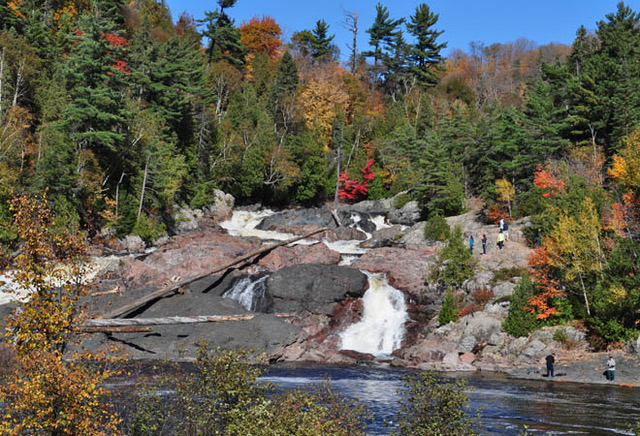
alan skeoch

